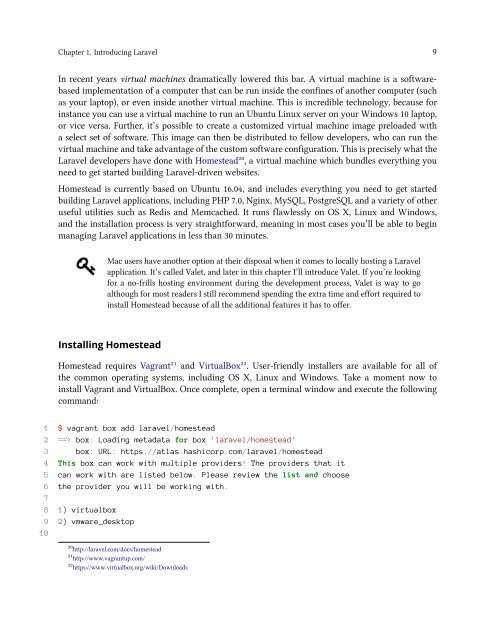easylaravel-sample
Create successful ePaper yourself
Turn your PDF publications into a flip-book with our unique Google optimized e-Paper software.
Chapter 1. Introducing Laravel 9<br />
In recent years virtual machines dramatically lowered this bar. A virtual machine is a softwarebased<br />
implementation of a computer that can be run inside the confines of another computer (such<br />
as your laptop), or even inside another virtual machine. This is incredible technology, because for<br />
instance you can use a virtual machine to run an Ubuntu Linux server on your Windows 10 laptop,<br />
or vice versa. Further, it’s possible to create a customized virtual machine image preloaded with<br />
a select set of software. This image can then be distributed to fellow developers, who can run the<br />
virtual machine and take advantage of the custom software configuration. This is precisely what the<br />
Laravel developers have done with Homestead²⁰, a virtual machine which bundles everything you<br />
need to get started building Laravel-driven websites.<br />
Homestead is currently based on Ubuntu 16.04, and includes everything you need to get started<br />
building Laravel applications, including PHP 7.0, Nginx, MySQL, PostgreSQL and a variety of other<br />
useful utilities such as Redis and Memcached. It runs flawlessly on OS X, Linux and Windows,<br />
and the installation process is very straightforward, meaning in most cases you’ll be able to begin<br />
managing Laravel applications in less than 30 minutes.<br />
Mac users have another option at their disposal when it comes to locally hosting a Laravel<br />
application. It’s called Valet, and later in this chapter I’ll introduce Valet. If you’re looking<br />
for a no-frills hosting environment during the development process, Valet is way to go<br />
although for most readers I still recommend spending the extra time and effort required to<br />
install Homestead because of all the additional features it has to offer.<br />
Installing Homestead<br />
Homestead requires Vagrant²¹ and VirtualBox²². User-friendly installers are available for all of<br />
the common operating systems, including OS X, Linux and Windows. Take a moment now to<br />
install Vagrant and VirtualBox. Once complete, open a terminal window and execute the following<br />
command:<br />
1 $ vagrant box add laravel/homestead<br />
2 ==> box: Loading metadata for box 'laravel/homestead'<br />
3 box: URL: https://atlas.hashicorp.com/laravel/homestead<br />
4 This box can work with multiple providers! The providers that it<br />
5 can work with are listed below. Please review the list and choose<br />
6 the provider you will be working with.<br />
7<br />
8 1) virtualbox<br />
9 2) vmware_desktop<br />
10<br />
²⁰http://laravel.com/docs/homestead<br />
²¹http://www.vagrantup.com/<br />
²²https://www.virtualbox.org/wiki/Downloads



